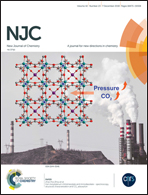Synthesis and reaction mechanism of high (BH)max exchange coupled Nd2(Fe,Co)14B/α-Fe nanoparticles by a novel one-pot microwave technique
Abstract
Nd–Fe–B based magnets, exhibiting the highest energy product, have a wide range of applications in industry. We developed a novel one-pot microwave synthesis technique to produce hard magnetic exchange coupled Nd2(Fe,Co)14B/α-Fe nanoparticles. Nd–Fe–Co–B mixed oxides were synthesized from metal nitrates via microwave combustion followed by microwave reduction of these oxides to hard magnetic Nd2(Fe,Co)14B powders in the same microwave chamber. The conventional use of a furnace for oxide reduction is eliminated. This method is cost effective, facile, energy efficient and widely applicable to a variety of materials. The detailed reaction mechanisms in both microwave combustion and microwave reduction were studied for the first time. During mixed oxide formation, the formation sequence is: boron oxide, iron oxide, cobalt oxide and finally, neodymium-iron mixed oxide. In the microwave reduction process, iron, cobalt and boron oxides were reduced, followed by reduction of neodymium oxide, resulting finally in the desired Nd2(Fe,Co)14B and α-Fe exchange coupled nanoparticles. The synthesized Nd2(Fe,Co)14B/α-Fe nanoparticles have a narrow size distribution with 60% in the size range of 35–45 nm. With a high remanence of 99 emu g−1, the maximum energy product of these hard-magnetic nanoparticles reached a value of 11.4 MGOe, which is the highest among the values reported for Nd2Fe14B/α-Fe nanoparticles synthesized by chemical approaches.



 Please wait while we load your content...
Please wait while we load your content...